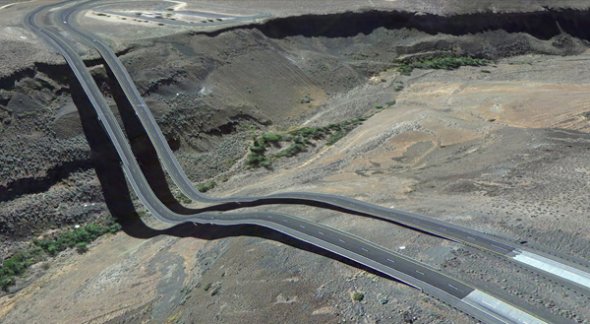Manifesto for a Theory of the ‘New Aesthetic’
Buy on Amazon UK £9.99 and other regions, Super Saving free shipping.
As the financial crisis fastens its grip ever tighter around the means of human and natural survival, the age of the algorithm has hit full stride. This phase-shift has been a long time coming of course, and was undoubtedly as much a cause of the crisis as its effect, with self-propelling algorithmic power replacing human labour and judgement and creating event fields far below the threshold of human perception and responsiveness.
At this high-point of high-tech, machines are producing aesthetic experiences for us as never before. Should we respectfully thank them and consider ourselves their peers? Curt Cloninger suggests something more irreverent
Aesthetic experience is always asymmetrical; it needs to be posed in terms of a subject, as well as an object.
– Steven Shaviro
What Is the ‘New Aesthetic’?
If, according to Debord, ‘the spectacle is capital accumulated to such a degree that it becomes an image’, then the New Aesthetic is technology accumulated to such a degree that it becomes an image. The New Aesthetic (NA) image is a special kind of image – an image which is bodily, affectively sussable by humans. The NA image is not merely (or even) an image to be intellectually pondered by humans. You ‘get it’ before you understand it (if you ever even come to understand it).
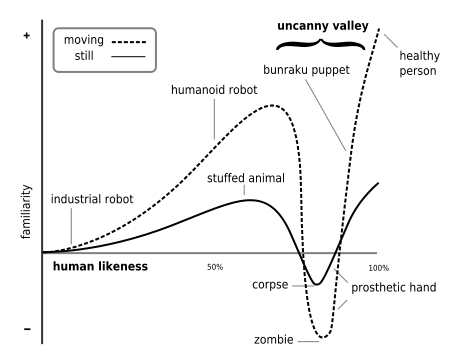
Image: Graph explaining the uncanny valley. This graph is not a New Aesthetic image
‘Things’ don't affectively suss the NA image. Only humans ‘get it’.
The New Aesthetic is not new (or it has always already been perpetually new). The fact that the NA has recently hit some sort of pop-meme coagulation tipping point (and acquired an ontological name) is merely evidence that technology has finally accumulated to the point of being easily and widely recognised as a collection of Tumblr images without needing to be supported or explained by any underlying theory whatsoever. (Indeed, James Bridle's Tumblr launched the New Aesthetic meme, and Bruce Sterling's journalistic blog dispersed it.) The New Aesthetic has been intuited by hands-on coders for decades (perhaps centuries). It has been discussed by media theorists for at least as long. This is why old school media artists like Mez Breeze and old school media theorists like Simon Biggs (on old school listservs like NetBehaviour) are left fairly unimpressed with the current ‘gee whiz’ enthusiasm about the New Aesthetic. ‘The future is already here — it's just not very evenly distributed’ (William Gibson, in some places as early as 1993). The future is (always already) in the process of becoming ever more evenly distributed.
When a meme (like ‘the New Aesthetic’) is initially introduced and received, it is arguably fruitful to leave off theorising about it and avoid trying to codify it. Let speculation and confusion reign and see where things lead. This approach works fine in the beginning; but after a while, it leads to the worst kind of lowest-common-denominator, self-referential, reblogged intellectual sludge.
The ‘New Aesthetic movement’ exists only in the imaginations of a group of bloggers promoting an agenda for which I have no sympathy whatsoever: actor-network theory spiced with pan-psychist metaphysics and morsels of process philosophy. I don’t believe the internet is an appropriate medium for serious artistic debate; nor do I believe it is acceptable to try to concoct an artistic movement online by using blogs to exploit the misguided enthusiasm of impressionable graduate students. I agree with Deleuze’s remark that ultimately the most basic task of art is to impede stupidity, so I see little artistic merit in a ‘movement’ whose most signal achievement thus far is to have generated an online orgy of stupidity. (Ray Brassier, in a 2011 interview for the Polish journal Kronos)
I have taken the liberty of replacing ‘speculative realist’ with ‘New Aesthetic’, ‘philosophical’ with ‘artistic’, and ‘philosophy’ with ‘art’.
The New Aesthetic is not a single aesthetic. Drone technology produces its own visual aesthetics. Google Maps produces its own visual aesthetics. Generative Processing code produces its own visual aesthetics. Glitches across various media, compression algorithms, and hardware displays produce their own visual aesthetics. These myriad aesthetics are each as singular and unique as the entangled culture/nature histories which led to the development and deployment of these various technologies and their gradual accumulation into human-sussable images.
The term ‘New Aesthetic’ is similar to the term ‘New Media’. When your descriptive adjective is as vague as ‘new’ (or ‘modern’ or ‘contemporary’), then all ontological constraints are off. Your movement is open to embrace ‘what's happenin'’ in the [future-]now.
The speculative playing field of the New Aesthetic is even broader than the speculative playing field of New Media; because ‘media’ are still indebted to the technical, formal, material constraints; whereas aesthetics (even ‘old’ Kantian aesthetics) have always been philosophically malleable.
Those less theoretically inclined might argue that since the New Aesthetic begins with an affectively intuited image, that's where it should end. Yo Bros, I’m really happy for you. Imma let you finish, but...
The New Aesthetic is not a new flavour of aesthetics. At best, and properly understood, it is a new way of understanding aesthetics altogether, one that renegotiates the relationship between human-subject and non-human-object. Perhaps we need a less historically-encrusted word for this ‘new’ relationship than ‘aesthetic’. But lets keep ‘aesthetic’ for now. It forces us to revisit Kant, Schiller, Freud, Heidegger, and Whitehead; and those guys had a lot of Tumblr followers back in the day.
‘I'm lost in the dark / Lend me your teeth.’ (Devendra Banhart, 2002). Post-Media theorist and curator Domenico Quaranta says the New Aesthetic will never be a critical criteria for art unless it grows some theoretical teeth. Currently, it is too preoccupied with surface sheen and not concerned enough with cultural analysis. Agreed. So let's try to grow it some teeth and see what happens...
A Process Without a Singular ‘Aesthetic’ Intentionality
The New Aesthetic image is like outsider art incidentally created by systems.
The New Aesthetic is indifferent to mimesis. The NA image is not the re-presentation of an object. The NA image is the incidental visual residue of the performance or enactment of a process. The process never intentionally alters itself in order to achieve the ‘goal’ of the NA image. The NA image is a trace, a remnant, a remainder, a residue, a (potential) clue. The ‘subject’ of the NA image (when sussed, aright) is the process itself. In this sense, the New Aesthetic is akin to process art, if we substitute ‘world’ for ‘studio’ and ‘human/non-human entanglements’ for ‘artist’.
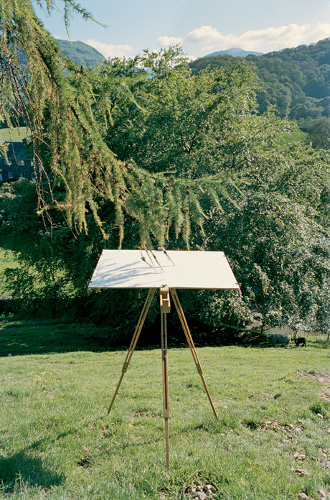
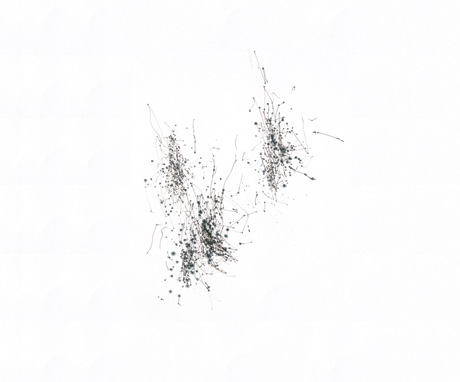
Images above: Traces of historical forces – Tim Knowles, Larch (4 pen) on Easel #1, 2005
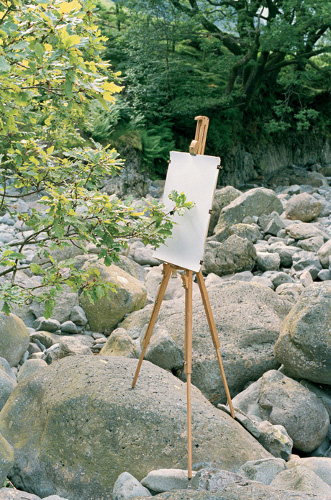
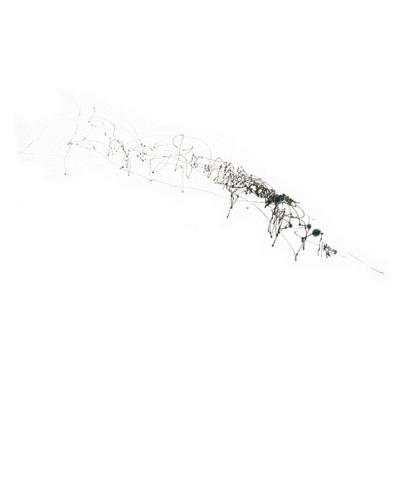
Image: Traces of different historical forces: Tim Knowles, Oak on Easel #1, 2005
The New Aesthetic image is a Leibnizian ‘texture’. It reveals more about the processes and systems that ‘produced’ it than it does about itself.
Technology was never evolving toward the production of this or that NA image. Beware of teleology! Technology was never trying to make this or that NA image. Beware of anthropocentrism! (Especially beware of the kind of anthropocentrism committed in the name of overcoming anthropocentrism.)
The difference between Pollock and Cage: Pollock's process is still heading toward the production of an aesthetic art object (as judged by his inherited idea of aesthetics). Cage's process is heading toward whatever it winds up being. For Cage, chance operations become a vehicle to escape inherited notions of aesthetics. New Aesthetic images are produced by processes that fall somewhere between Pollock and Cage. NA images are not produced solely by randomness, nor are they produced in order to conform to a pre-conceived human aesthetic. NA images are produced by entangled nature/culture systems. Thus, human will is always partially involved in their production, but it is rarely an aesthetic will heading toward the production of NA images. Usually, it is the will to make more money, modulated through complex technological entanglements which have accumulated to such a degree that NA images are incidentally (although not arbitrarily) produced. To fetishise the NA image as a mere ‘aesthetic’ object is to conveniently ignore the ethical ways in which we are implicit in its production. To fetishistically credit ‘machines’ as the primary agents behind the production of NA images is to conveniently ignore the ethical ways in which we are implicit in their production.
The New Aesthetic image, in-and-of-itself, in stasis, is kind of cool. Cooler yet is the way in which the NA image reveals the historical forces that have come together to ‘produce’ it in stasis. Coolest is the way in which the NA image reveals how things are currently coming together in process; and how things may possibly come together in the near future.
New Aesthetic images aren't representative, analogous, archetypal, emblematic, or symbolic of any thing else. They are the actual traces and residues of processes and relationships – traces that have arrived in the visual realm and have entered humans via their eyes. NA images don't symbolise or represent the processes that have led to their creation. Instead, they are incidentally thrown into the world by those processes. The way backwards from the images toward the processes themselves is much more complicated that simply intellectually thinking about what these images look ‘like’. We initially apperceive NA images bodily and affectively. They are freaky. They trip us out. Only later are we able to reflect on them analytically, letting their own systemic contours and folds guide our theoretical thought.
Because NA images are apperceived and explored along affective lines, submitting these images to pre-existing modes of critical theory (Marxism, feminism, post-humanism, futurist journalism) may not be enough. What escapes may be more fruitful than what is captured.
Which thinkers are most relevant to the development of a New Aesthetic theory? Deleuze starts to become pragmatically (not just speculatively) relevant. (This might turn out to be ‘his century’ after all.) Bruno Latour becomes increasingly relevant. Benjamin and Debord remain relevant, but less for their Marxism than their moxie. Baudrillard is a wild goose chase (but then he always was). Graham Harman is a bit of a detour (leading to a dead-end overlooking a noble vista). Whitehead is spot on (but then he always was).
We are not merely left to choose between cyber-utopianism and cyber-dystopianism. Because, like modernism/postmodernism, utopia/dystopia are two sides of the same teleological coin. As Bruno Latour rightly asserts, we have never been modern, we just fooled ourselves into thinking we were. When the truly new emerges, if it is indeed properly new, it won't look like utopia, dystopia, modernism, or postmodernism. It will look (and feel) monstrous and uncanny. ‘The future can only be anticipated in the form of absolute danger. It is that which breaks absolutely with constituted normality and can only be proclaimed, presented, as a sort of monstrosity.’ (Derrida, 1967).
New Aesthetic Images are Affectively Sussed By Humans, Not by Things
An overdub has no choice / an image cannot rejoice’
– Carole King, 1968
It bears repeating: ‘Things’ don't affectively suss New Aesthetic images. Only humans ‘get’ NA images. There is no machine ‘aesthetic’, no robotic ‘vision’. Humans invent aesthetic theories regarding the interpretation of machine-generated images. Machines do not invent aesthetic theories regarding the interpretation of circuit-generated images. Likewise, no rock ever invented an ontology. Humans develop ontologies which include rocks. Humans may even philosophically speculate what ontologies rocks might invent. But rocks-themselves do not invent rock-centric ontologies. Nor do rocks-themselves philosophically speculate what ontologies dirt might invent.
If there were a clear dividing line between humans and things, then the ‘aesthetics’ of the New Aesthetic would lie mostly on the side of humans. Between humans and things, there is no clear dividing line.
The New Aesthetic is not just about intellectually ‘getting it’ when it comes to technology. Heck, Paul Simon ‘gets it’ as early as 1986:
The bomb in the baby carriage was wired to the radio... The way the camera follows us in slo-mo. The way we look to us all. The way we look to a distant constellation that's dying in a corner of the sky. These are days of miracle and wonder... And the dead sand falling on the children, the mothers, and the fathers, and the automatic earth... Medicine is magical and magical is art... lasers in the jungle somewhere... Staccato signals of constant information. A loose affiliation of millionaires and billionaires.
Simon's lyric reads like a (much more poetic) version of any number of summative lists recently offered to catalogue the underlying technologies of the New Aesthetic. And that's Paul Simon in 1986. Yes, we all get it. We have gotten it for some time now.
The most intriguing thing about the New Aesthetic is that we all now ‘get it’ affectively via NA images. Our human bodies have a way of ‘getting it’ before our human intellects do.
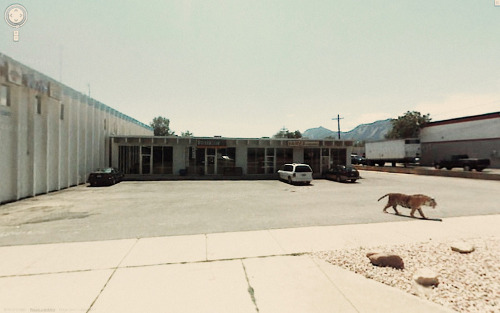
Image: Jon Rafman, from 9-eyes.com, ongoing. Artist/curator/human Jon Rafman 'gets it', The 9-eyed, vehicle-mounted, Google camera apparatus does not
New Aesthetic images can teach us humans a New Aesthetic. But as we listen to this New Aesthetic, what we are hearing is neither the pure voice of nature nor the adulterated voice of machines. We are listening to systems in the world – a world that we are co-creating, a world of which we are always already a part (never apart).
Down With Pan-Psychism!
Pan-psychism is the idea that all things in the world (rocks, animals, predator drones, weather systems, Hello Kitty lunchboxes) have consciousness. The pipe dream of Artificial Intelligence is related to pan-psychism. Pan-psychism is the played-out rabbit trail of the New Aesthetic. ‘It's a trap!’ (Admiral Ackbar). Just because we've finally come to recognise that things and systems have their own agency and are not merely passive and inert, this doesn't mean that things and systems have consciousness.
We humans have become so enamoured of honouring ‘the other’ that we have come to equate self-denigration with ethical behaviour. Not only do we see ourselves as sexist and racist (which we are), we have come to see ourselves as species-ist (animals are people too) and thing-ist (things are people too). The irony is, as we seek to honour things-in-themselves (thus nobly overcoming our anthropocentric narcissism), we extend to things the highest honour we can imagine – humanness! To imbue things and systems with a kind of consciousness is actually the epitome of anthropocentrism. The conquering European must first dress the native up in civilised clothes before she can be treated as an equal. And now we extend the same ridiculous, narcissistic ‘courtesy’ to things.
It is not enough that we seek to elevate things to our level; we feel as if we must lower ourselves to thing level. We humans are now no better than things. We are actually mere things ourselves (or mere systems of micro-things, depending on your scalar preferences). And the rocks bow their heads as we pass by, in deference to our enlightened humility.
As a result, we humans are hubristically tempted to attribute the uncanniness of New Aesthetic images to the pan-psychic agency of AI technology. ‘Gee, these systems must be sentient (in a way that we humans are sentient), because we humans sure didn't invent these crazy new images.’ This response is half-right and all wrong. We humans had a ‘hand’ in inventing these images, but ours was not the only ‘hand’. Systems, materials, things, assemblages co-invented these NA images with us.
Up with Pan-Experientialism!
Pan-experientialism is the idea that all things in the world experience ‘being’ over time. Forces and events in the world ingress into things in a way that is experienced by those things.
Few things have the same qualitative types of experience. Rock-being-ness isn't human-being-ness (and human-being-ness isn't what it used to be). Alfred North Whitehead puts it like this: experience is the base of all being; consciousness is the apex of all being. So although rocks don't think like humans (indeed, rocks don't think at all), at some base level of being, humans and rocks both experience.
Furthermore, humans don't consciously ‘think’ everything that we ‘experience’. We affectively and bodily experience all sorts of things we don't ever think at all. Only a fraction of our human experiences ingress into our conscious (or even subconscious) awareness.
Pan-experientialism means that humans are a little more like things than we thought, and that things are a little more like humans than we thought. It doesn't mean that humans are mere rocks, or that rocks have consciousness.
We need to understand things as vector forces enacting within networks, not as anthropomorphised objects. Yes, thing have agency, but their agency is altogether thingy. Emergent systems (a.k.a. things made up of things) exercise all sorts of funky agency: flocking behaviours, attraction to strange attractors, radical modulations at state-change thresholds. Yes, non-inert behaviours; but not sentient behaviours. A painter enters into a kind of pragmatic dialogue with the viscous and luminous behaviours of her paint. She need not speculate about its withdrawn essence.
New Aesthetic Images: The Uncanny, the Present-At-Hand, the Sublime
Kansas, I've a feeling we're not in Toto any more
– Dorothy (chopped & screwed)
Aesthetics are related to both experience and consciousness. Aesthetics are born in experience and arrive at consciousness. No consciousness at which to arrive, no aesthetics. So when we talk about aesthetics, we're mostly talking about humans. (Unless we want to radically re-define aesthetics, in which case we should probably use a different word.)
Beginning with Freud: New Aesthetic images are uncanny (unheimlich, un-homelike). If NA images were totally familiar, we would read them as family photos. (They are our new family photos.) If they were totally alien, we would read them as so much white noise. Instead, New Aesthetic images are somewhere in-between, in the Uncanny Valley: that disturbing interzone where something ‘non-human’ is almost human enough to seem ‘human’, but not quite. We recognise ourselves in NA images, but also something other than ourselves; or rather, still ourselves – but ourselves complicated, enmeshed, othered.
We humans are developing new, more purposefully affective ways of reading these new images.
The only way to read is acrobatically, fast and with lots of background noise (disco music or television), for that encourages more speed and more rapid processing of the information that cannot be processed except as a function of peripheral seeing and distracted absorption… To read poetry carefully and slowly is to miss the point, which is the blur.
– Tan Lin, Cabinet Magazine, Issue 1, 2000/2001
On to Heidegger: Graham Harman interprets Heidegger's vorhandenheit (presence-at-hand) as an eruption of the thing out of its normal function in the world (its normal function is zuhandenheit, ‘readiness-to-hand’). The thing was there all along; but we never saw it this way until now. This eruption is a useful way of understanding NA images. NA images are visual eruptions of everyday functioning systems in the world, systems humans never saw in this way until now. Like Heidegger's broken hammer – the carpenter only stops to reflect on it once it stops working as expected.
New Aesthetic visuals don't necessarily ‘reveal’ a hidden ‘truth’. It's not as if readiness-to-hand is false and presence-at-hand is true, or vice versa. They are just two simultaneous ways of being in the world. (Heidegger's genius – his ‘sleight of hand’ – was to draw our attention to readiness-to-hand without turning it into presence-at-hand.)
As per Bruno Latour (and with Heidegger turning in his grave), our current systems have proliferated and hybridised beyond our ken to strange and complex degrees. New Aesthetic images strike at the heart of the modernist myth that man is master and measure of all things. Something much more trippy is actually happening. We are caught up in a proliferation of hybrid hammers ever breaking.
From Heidegger to Kant: New Aesthetic images are more sublime than beautiful. They are sublime because they affectively impact humans in ways which imply the subterranean, ongoing operation of assemblages which have not yet been resolved, and may never resolve; assemblages beyond human mastery, yet in which humans are implicated and entangled. The affective feelings NA images evoke in humans confound Schiller's attempts to reconcile the sensuous and the formal in ‘play’. NA images are neither human ‘art’ nor non-human ‘nature’. They were not created to address a static conception of human nature, nor to dialectically overcome preconceived contradictory drives within human nature. Neither were they created by extra-human forces in order to provide human ‘subjects’ with ‘natural’ objects for aesthetic contemplation. Instead, NA images are residues that result from current ways of being in the world, entangled ways in which humans are ‘always already’ implicated. At their best, NA images challenge humans to re-imagine ‘humanness’ ‘being’ and ‘the world’ altogether.
Four Summaries, Three Quotations and a Closing Exhortation
Matter matters. Things (light, networks, economies, rocks, paint, pixels) have their own agency. Things are already in the world, in dialogue with the world, forming and being formed by other things in the world. Indeed, according to Heidegger, things in relationship with other things make up ‘the world’. No things; no ‘world’. Things don’t consciously ‘know stuff’ about the world, but... things behave in ways derived from their history in the world and from their current entanglements with the world. Things are caught up in the world (of other things), and the world is caught up in things.
‘What might things make of the New Aesthetic?’ is not a very useful question. ‘What might humans make of the New Aesthetic once we realise that we have been entangled with things all along?’ is a more useful question. Bruno Latour says that modernism was simply a time when humans thought we weren't entangled with things, when actually we were. What we made of that time unawares was an even bigger entangled mess (Latour's term is ‘a proliferation of hybrids’) – atom bombs as inverted guardian angels, global warming debates as orthodox scientific catechisms. At this point, it seems unlikely that we are going to avoid further complex human/thing entanglements, so trying to avoid them is probably something we should try to avoid. On the other hand, we should also avoid passively sitting around, techno-fetishistically dazzled by these ‘spectacular new developments’, blithely watching a real-time documentary of ourselves watching a real-time documentary of ourselves. Probably, we should spend some time figuring out how these systems flow and function so we can more effectively modulate them (or sabotage them), hopefully for reasons other than making more money.
All of this stuff is cool. Does it mean that objects have souls, psyches, withdrawn essences, or intelligences? No. Does it mean that humans are merely one thing among many things, no more or less endowed with agency? No.
It does mean that humans are recursively entangled with things and forces in increasingly problematic ways (Bruno Latour told us this in 1991.) Furthermore, it means that humans affectively experience all sorts of things in the world prior to (and often without ever) cognitively becoming aware of these experiences; it means that things also affectively ‘experience’ forces in the world; and it means that systems, ideas, networks, entanglements, forces, events, technologies, animals, humans and objects are all ‘things’ in ‘the world’. (Whitehead told us this in 1927. His word for ‘things’ is ‘entities.’) The fact that a bunch of people are currently talking about all this stuff online simply means that our technology has accumulated to such a degree that it has become an image – an image we can all (tech geeks, object oriented philosophers, sci-fi journalists, tumblr-ing graphic designers, twenty-something net.artists, rocks) affectively suss.
*
‘I have no doubt that in reality the future will be vastly more surprising than anything I can imagine. Now my own suspicion is that the Universe is not only queerer than we suppose, but queerer than we can suppose.’ (J. B. S. Haldane, 1927).
‘There is no need to fear or hope, but only to look for new weapons.’ (Gilles Deleuze, 1990).
‘Be very very quiet / Clock everything you see / Little things might matter later / At the start of the end of history.’ (Steely Dan, 2003).
*
Do carry on funking & wagging, but with rigour. Little things might matter later.
Curt Cloninger <curt AT lab404.com> is an artist, writer and Assistant Professor of New Media at the University of North Carolina Asheville, USA. His art undermines language as a system of meaning in order to reveal it as an embodied force in the world. He maintains http://lab404.com, http://playdamage.org and http://deepyoung.org in order to facilitate a more lively remote dialogue with the Sundry Contagions of Wonder
Mute Books Orders
For Mute Books distribution contact Anagram Books
contact@anagrambooks.com
For online purchases visit anagrambooks.com


